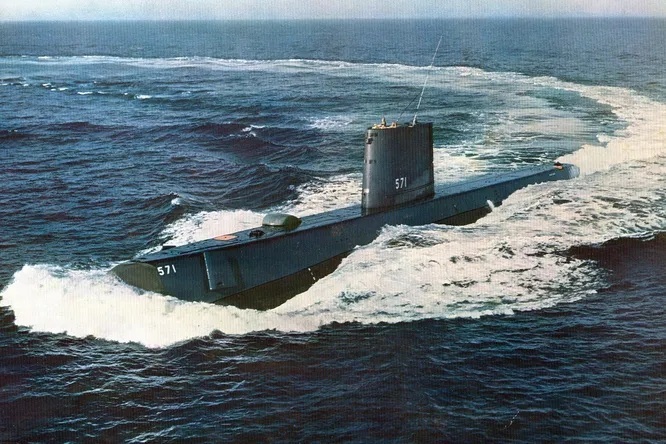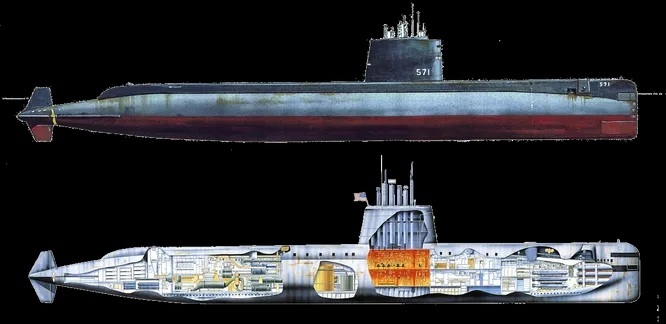The facts about America’s first underwater superweapon
Nuclear-powered submarines will help the US Navy reduce the large number of tankers at sea and reduce the fleet’s maritime logistics needs.
On September 30, 1954, the US Navy commissioned the world’s first nuclear submarine. This submarine, named after a fictional ship in the works of writer Jules Verne, has been in service for a quarter of a century and has become a pioneer in many ways at once.
 |
| USS Nautilus was the world’s first nuclear submarine, sparking a race in the sea between the US and the Soviet Union. |
Nuclear submarines were developed for about 6 years
In 1948, the US Navy established the Nuclear Energy Force, starting a revolution in the field of military submarine engines. In August 1949, operational data for the first nuclear submarine was approved, the ship was laid down on June 14, 1952 in the presence of President Harry Truman at the shipyard in Groton and was named Nautilus (USS Nautilus, SSN-571).
In 1954, in the presence of President Dwight Eisenhower, the mistaken ship Nautilus was launched and then handed over to the US Navy.
The Nautilus’ crew consisted of 13 officers and 92 sailors. The ship is equipped with 6 533 mm torpedo tubes in the bow and carries 24 torpedoes.
Great weight but moves pretty fast
The Nautilus differs from a diesel-electric train not only in the presence of a new power plant, but also in the design of the hull. With a displacement of about 4,000 tons, the ship is equipped with a two-axle nuclear power plant of the Westinghouse brand S2W with a total capacity of 9,860 kW (13,800 hp), with a speed of more than 20 knots/hour. .
Submarines set sail in 1955
On January 17, 1955, the Nautilus sailed for the first time, and first captain Eugene Wilkinson sent a historic message: “We are using atomic energy”.
During her years of service, the USS Nautilus broke many submarine voyage records, including a 2,222 km dive from New London, Connecticut to Puerto Rico in 90 hours.
Nautilus has reached the North Pole
In August 1958, the Nautilus became the first ship in history to reach the North Pole. A year earlier, the first attempt at such a campaign had failed. As the ship sailed under thick ice, the Nautilus attempted to surface, but encountered an iceberg, severely damaging the sole periscope.
Nautilus “so outstanding”
The design of the Nautilus has significant flaws. So, the specific gravity of installing a nuclear reactor turned out to be very large, which is why it was not possible to install a part of the weapons provided by the project on board. The ship alone weighed about 35 tons. While the weight of the biological protective layer, which includes lead, steel and other materials, is about 740 tons.
 |
| At that time, putting a nuclear reactor on a submarine was considered a very risky decision, because a very small mistake could turn the whole ship into a giant atomic bomb. |
The problem with the boat was the noise it made. Active turbines create such a vibration that sonar (a technique that uses the propagation of sound to navigate and communicate) becomes useless at 4 knots. The ship became “too prominent” with the noise it made that made that clear. This shortcoming was taken into account by the Americans when designing the next nuclear submarines.
Sailors must look for leaks
There are also humorous episodes in the life of Nautilus. In May 1958, during preparations for a trip to the North Pole, the main condenser of a steam turbine engine leaked water. Outside water seeping into the water supply system can cause salinization of the secondary circuit and lead to failure of the entire electrical system of the ship. Attempts to locate the leak were unsuccessful and the submarine commander made an initial decision.
After the Nautilus arrived in Seattle (Washington, USA) sailors in civilian clothes bought all the fluids in auto stores to pour into the ship’s radiator to prevent leaks. Half of this liquid (about 80 liters) was poured into the condenser, then neither in Seattle, nor during the campaign, the condenser salinization problem arose. Presumably, the leak was in the space between the condensers and stopped after filling this space with a self-hardening mixture.
Pioneering in the Mediterranean
In August 1960, the world’s first nuclear submarine was commissioned for the US Navy’s 6th Fleet and later became the first nuclear submarine in the Mediterranean.
Nautilus turned into a museum
After 25 years of serving the US Navy with a total of 2,507 dives and more than 820,000 km of journeys without any incident. The Nautilus proved that nuclear-powered ships were safe and effective, paving the way for the US Navy to build a massive nuclear submarine fleet.
In 1980, the Nautilus was honored as a symbol of American strength. The Nautilus was removed from the fleet and in 1982 the ship was declared a national historic site. Plans have been made to convert the submarine into a museum for public display. On July 6, 1985, the Nautilus was on display at the U.S. Submarine Force Museum in Groton, Connecticut.
Peace (translation summary)
at Blogtuan.info – Source: infonet.vietnamnet.vn – Read the original article here



